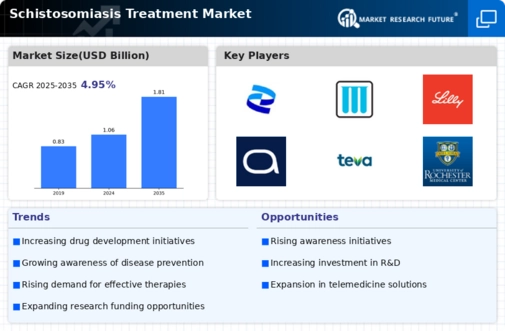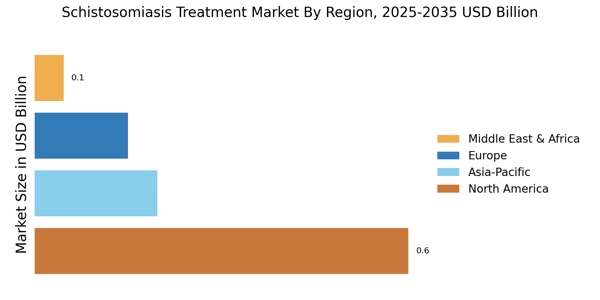Rising Incidence of Schistosomiasis
The increasing incidence of schistosomiasis, particularly in endemic regions, appears to be a primary driver for the Schistosomiasis Treatment Market. According to recent estimates, approximately 240 million people are infected with schistosomiasis worldwide, with the majority residing in Africa and parts of Asia. This rising prevalence necessitates effective treatment options, thereby propelling market growth. The World Health Organization has emphasized the need for enhanced treatment strategies, which may lead to increased funding and research initiatives. As awareness of the disease grows, healthcare systems are likely to prioritize the development and distribution of effective therapies, further stimulating the Schistosomiasis Treatment Market.
Advancements in Treatment Modalities
Recent advancements in treatment modalities for schistosomiasis are likely to significantly influence the Schistosomiasis Treatment Market. The introduction of novel therapeutic agents and improved formulations of existing drugs, such as praziquantel, may enhance treatment efficacy and patient compliance. Furthermore, ongoing clinical trials are exploring combination therapies that could potentially offer better outcomes. The market is also witnessing the development of long-acting formulations, which could reduce the frequency of dosing and improve patient adherence. These innovations not only address the current treatment gaps but also align with the growing demand for more effective and user-friendly treatment options in the Schistosomiasis Treatment Market.
Increased Government and NGO Funding
The Schistosomiasis Treatment Market is experiencing a surge in funding from government bodies and non-governmental organizations (NGOs). This financial support is primarily directed towards research, development, and distribution of treatment options. For instance, initiatives aimed at eliminating schistosomiasis as a public health problem have garnered significant investment, with millions allocated for drug distribution and awareness campaigns. Such funding is crucial for enhancing access to treatment in endemic regions, where healthcare resources are often limited. The commitment from various stakeholders to combat schistosomiasis is likely to foster innovation and expand the market, ultimately benefiting those affected by the disease.
Emerging Markets and Economic Development
Emerging markets, particularly in Africa and Southeast Asia, are witnessing economic development that could positively impact the Schistosomiasis Treatment Market. As these regions experience growth, there is a corresponding increase in healthcare investments and infrastructure improvements. Enhanced economic conditions may lead to better access to healthcare services, including schistosomiasis treatment. Additionally, as governments prioritize health initiatives, the allocation of resources towards combating neglected tropical diseases like schistosomiasis is likely to increase. This trend suggests a potential expansion of the market, as improved economic conditions facilitate greater access to effective treatments and raise awareness about the disease.
Growing Awareness and Education Initiatives
The growing awareness and education initiatives surrounding schistosomiasis are expected to play a pivotal role in shaping the Schistosomiasis Treatment Market. Public health campaigns aimed at educating communities about the disease, its transmission, and prevention strategies are becoming increasingly prevalent. These initiatives not only inform individuals about the importance of seeking treatment but also encourage preventive measures, which may reduce the overall incidence of the disease. As awareness increases, the demand for effective treatment options is likely to rise, prompting healthcare providers to prioritize the availability of therapies in affected regions. This heightened focus on education and awareness is anticipated to drive growth in the Schistosomiasis Treatment Market.


















Leave a Comment